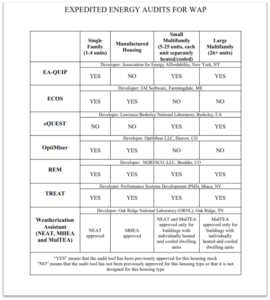Home Energy Audits
A home energy audit includes a comprehensive assessment of the current condition of a home followed by a detailed evaluation of the energy conservation measures that can improve the building’s performance. The first step – the comprehensive assessment – takes place at the home and includes visual and diagnostic assessments of the whole home as a system, including the building shell, heating and cooling systems, and appliances. Combustion appliances are tested for safety and efficiency, existing insulation levels are determined, air leakage is measured, electrical appliances are metered, moisture and other health hazards are evaluated, and the residents are interviewed about energy usage, trouble areas in the home, and health issues that may be connected to the indoor environment.
The data collected during the comprehensive assessment, or site audit, is then entered into an approved energy audit software tool (Click the matrix above for more information), such as the DOE Weatherization Assistant. Based on the local climate, energy rates, the costs of materials and labor, and the current condition of the home, the software evaluates the cost-effectiveness of home energy retrofit measures. Typical cost-effective measures include air sealing and insulating the building shell, heating and cooling system tune-ups, repairs, or replacements, and duct sealing and insulation. In addition to the energy conservation measures, the auditor will recommend measures to improve the health and safety of the residents. Typical health and safety related measures include adding mechanical ventilation to kitchens and bathrooms to manage moisture and other indoor pollutants, installing vapor barriers on dirt-floored basements or crawl spaces, and installing smoke/CO detectors. The successful energy audit results in a work order of measures that, when installed, will reduce energy consumption and potentially improve the health of occupants.






